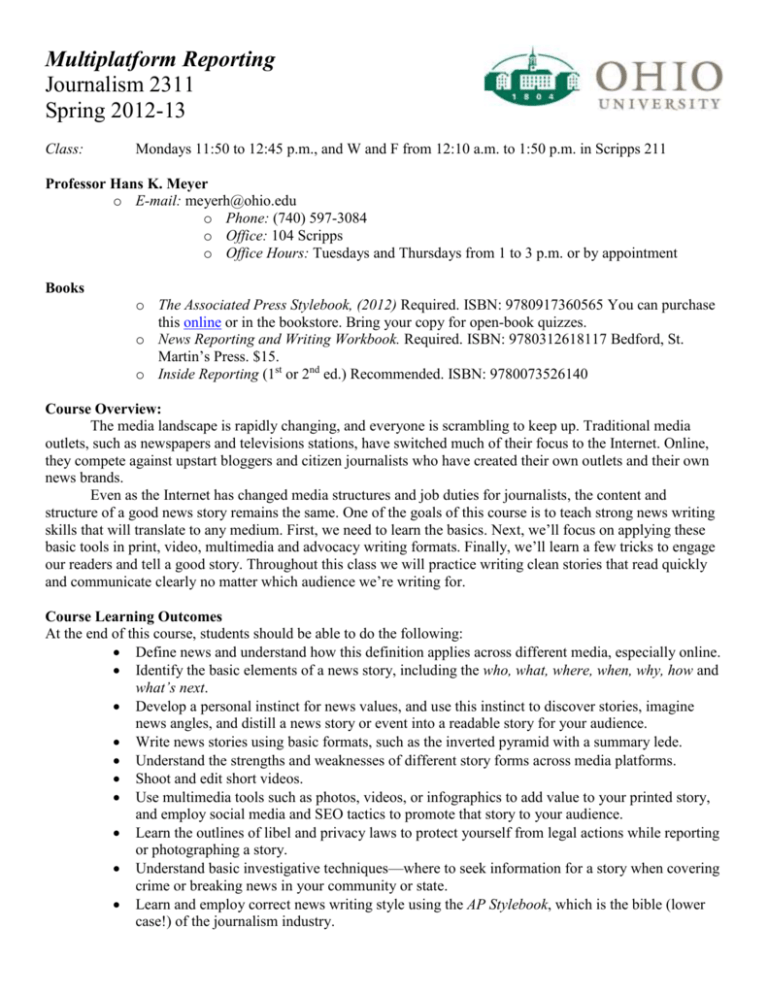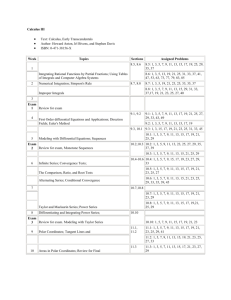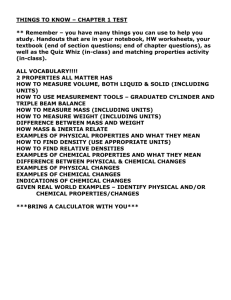JOUR2311: Multi-plaform Reporting
advertisement

Multiplatform Reporting Journalism 2311 Spring 2012-13 Class: Mondays 11:50 to 12:45 p.m., and W and F from 12:10 a.m. to 1:50 p.m. in Scripps 211 Professor Hans K. Meyer o E-mail: meyerh@ohio.edu o Phone: (740) 597-3084 o Office: 104 Scripps o Office Hours: Tuesdays and Thursdays from 1 to 3 p.m. or by appointment Books o The Associated Press Stylebook, (2012) Required. ISBN: 9780917360565 You can purchase this online or in the bookstore. Bring your copy for open-book quizzes. o News Reporting and Writing Workbook. Required. ISBN: 9780312618117 Bedford, St. Martin’s Press. $15. o Inside Reporting (1st or 2nd ed.) Recommended. ISBN: 9780073526140 Course Overview: The media landscape is rapidly changing, and everyone is scrambling to keep up. Traditional media outlets, such as newspapers and televisions stations, have switched much of their focus to the Internet. Online, they compete against upstart bloggers and citizen journalists who have created their own outlets and their own news brands. Even as the Internet has changed media structures and job duties for journalists, the content and structure of a good news story remains the same. One of the goals of this course is to teach strong news writing skills that will translate to any medium. First, we need to learn the basics. Next, we’ll focus on applying these basic tools in print, video, multimedia and advocacy writing formats. Finally, we’ll learn a few tricks to engage our readers and tell a good story. Throughout this class we will practice writing clean stories that read quickly and communicate clearly no matter which audience we’re writing for. Course Learning Outcomes At the end of this course, students should be able to do the following: Define news and understand how this definition applies across different media, especially online. Identify the basic elements of a news story, including the who, what, where, when, why, how and what’s next. Develop a personal instinct for news values, and use this instinct to discover stories, imagine news angles, and distill a news story or event into a readable story for your audience. Write news stories using basic formats, such as the inverted pyramid with a summary lede. Understand the strengths and weaknesses of different story forms across media platforms. Shoot and edit short videos. Use multimedia tools such as photos, videos, or infographics to add value to your printed story, and employ social media and SEO tactics to promote that story to your audience. Learn the outlines of libel and privacy laws to protect yourself from legal actions while reporting or photographing a story. Understand basic investigative techniques—where to seek information for a story when covering crime or breaking news in your community or state. Learn and employ correct news writing style using the AP Stylebook, which is the bible (lower case!) of the journalism industry. Required Texts The Associated Press Stylebook, (2012) You can purchase this online or in the bookstore. Although it is possible to subscribe online for electronic access to the Stylebook, you may be best served with a physical copy of the book for openbook quizzes. Recommended text Inside Reporting, by Tim Harrower 1st or 2nd ed. This book is particularly recommended if you are interested in print or magazine journalism. Mr. Harrower has a talent for bringing together interesting content in a newspaper-like format. The book contains lots of great “war stories” from inside the newsroom, plus a “morgue” of sample stories you can use for inspiration and direction. Required Equipment During the semester, students will complete at least two video assignments. The Scripps school will supply the cameras and lab computers for editing. Students, however, will need to buy the following: An SD memory card (at least 8 GB, Class 10 read/write speed recommended) An SD card reader. Bring it to class on video editing days. The Mac computers in our classroom do not have SD card readers. A portable hard drive (preferably one that does NOT require an extra power source) Course Expectations The main focus of this class is writing, and we will try to mix in-class and outside-of-class projects to ensure students understand the writing concepts and feel confident applying them in the real world. You will be expected to meet all story deadlines, even if sources fail to contact you. You are expected to attend all classes, including Monday sessions. You must subscribe to The New York Times online. Attendance Policy Students are expected to attend class regularly and on time, to participate in class discussions, and to complete reading assignments prior to class. Attendance will be taken through in-class writing exercises, student presentations, and AP style quizzes. If you miss class, you miss the points. YOU WILL NOT BE ALLOWED TO MAKE-UP THE IN-CLASS EXERCISES. I may make an exception if you miss class because of a death in the family, a doctor-attested illness, or a university-approved activity. All three instances require some form of documentation. In addition, this course will meet Monday with the other sections in a large group setting. These Monday lectures will supplement the class by providing insight on the changing nature of journalism and its integration on the Web. Attendance at all of these presentations is expected. To check attendance, the instructor will base part of the weekly AP style quizzes on Monday lectures. Course Activities 1. Beat Memo: At the start of the second week of class, students will be required to select and defend an area they would like to cover. This will be their beat. Students will use this beat to complete the outside-of-class writing and multimedia assignments. When writing the beat memo, they should be sure to identify events that will fall within the deadline periods, as well as locate sources they can rely on for information. They must also justify why this area and these stories are worth covering. I will read beat proposals carefully and provide feedback to help you identify possible story pitches. You are responsible, however, for identifying and completing all the stories. This beat memo is a good way to get you started early. Students who complete the beat memo according to the grading criteria will receive full credit for this assignment. 2. In-class writing assignments: Basic news writing is a craft, and like any craft, you get better with practice. Knowing this, we will polish our chops by doing MANY in-class writing assignments. This gives you a chance to learn by doing, so you’ll avoid the basic mistakes when you go out to research and write larger projects. These in-class assignments are credit/no-credit and are worth 20 points. You will upload most of your in-class writing to Blackboard so we can do group critiques of each other’s stories. Occasionally I will ask you to print a story out for more in-depth written reviews. 3. News Writing Projects: For this class, students will be asked to complete three common types of stories every reporter faces: the breaking news story using inverted pyramid style, covering an event while advancing an issue, and a longer issue or profile story with multimedia elements. A grading rubric for each of these stories will be posted on Blackboard. Five points will be docked for every day they are late. Deadlines are important, but if you are having problems, please communicate with me about your work. 4. AP Style presentations: Once during the semester, each student will lead the class in a 10-minute discussion about a section in the AP Stylebook. I will supply lists of useful stylebook entries for each section to guide you. I will also add to the presentations when necessary. 5. Two News Videos/Final Cut Pro X practice: Students will create at least two videos in this class; one early in the semester as an in-class assignment, and another as a graded outside-class project. For the first video, we will focus on learning to use the camera and editing software, and we will do all the editing during class. The second video will require more time and skill, and you will have limited class time to work on it. You may NOT use your own computer or camera for these projects. We will be learning to use Final Cut Pro X, and using different cameras complicates this process. More information will accompany the grading rubric for each project. 6. Final Project: The final project will represent a culmination of the activities in the course. This will be a well-researched issue, focus, or news story on a topic of your choice. It will be at least 750 words and will have at least five people quoted as sources. You will be required to submit a rough draft of the story, which you will review with one or two of your peers. You must also include two multimedia elements with your story. You must choose the best ones for your project. One element must be a 90-second video with at least two sources. The others can be a sidebar story, an infographic, an audio story, a set of photographs and captions, a magazine or newspaper layout. The requirements for these multimedia elements will be described in more detail in the assignment rubric. You must upload your story onto Blackboard. You must also publish it to our class blog and use social media and SEO strategies to promote it to your audience. 7. No Final Exam: There is no formal final exam for this class. We will use the final exam meeting time to present our final projects to each other to give critical feedback and kudos. 8. AP Style and News Quizzes: During the semester, students will take AP style quizzes during the first 12 minutes of some classes. Be sure to get here on time so you have all 12 minutes to finish. These quizzes are open book, so bring your AP Stylebook to class. The 15 or so questions will cover AP style entries from that week, as well as a few bonus questions from the week’s top news stories and the content of the Monday lectures. You will NOT be allowed to make up quizzes if you miss them. 9. Extra Credit: There is no formal extra credit for this course. However, your lowest AP quiz score and one of your in-class assignment scores will be dropped. If you miss an assignment or quiz, the zero will count for the dropped score. You may not miss the first video assignment. Course Policies Class time: We’ve already discussed attendance, but showing up isn’t enough. Bring your AP stylebook and your textbook to each class. Please participate in discussions. In addition, avoid activities that will distract you. This includes the following: Cell Phones: Please turn them off or set them to vibrate. Don’t text during lectures or presentations. It’s rude. If I see you texting in class, I will ask you to leave. Web surfing: Please pay attention. Do not check your Facebook page. We are in a computer lab, so I know this will be a temptation. Please avoid it. There will be times when surfing is perfectly acceptable. These times will be apparent. Camera checkout: Panasonic Lumix cameras will be available in RTV 371A. These cameras shoot 12 megapixel still photos and HD video. Here’s the rules about camera checkout: o Students can check out cameras for a 48-hour period. If they are not returned within that time frame, the student will be charged a $10 late penalty. When students check out a camera, they receive and must return the following: A Lumix camera with an identification number A battery A battery charger A fabric case Cables or SD cards are NOT provided. A card reader for editing is also NOT provided. Blackboard: We use Blackboard extensively in this class. I send group emails, make grading rubric available, and sometimes post additional readings on the site. If you do not have access to Blackboard, please contact the Ohio Instruction Technology Office to get signed up. I will provide some instruction on how to use Blackboard and associated technology in class. Deadlines: In a real-world news organization, deadlines are extremely important, and journalists and writers must learn to use the pressure to churn out a story on time. I want you to get some experience writing under pressure. Therefore, late work will NOT be accepted unless you’ve spoken to me beforehand, and even with permission, your grade will decline by 5 points each day it is late. This represents the same process by which you’d clear a late story with your editor at a professional news organization, and the resulting heat you’d take for being late. Don’t make a habit of this—it reflects poorly upon you as a reporter. Deadlines for assignments are as follows: o In-class writing: Posted to Blackboard before the end of class, unless otherwise noted. o Outside-of-class writing: Printed copy in my hands and digital copy uploaded to Blackboard at the beginning of class on due date. Style / Grammar: All written work in this class should follow AP style and accepted rules of grammar and punctuation for American English. All style and grammar errors in your stories will receive a 1point deduction from the final grade. If you don’t know the style for a particular phrase or word, look it up. That’s part of the AP stylebook process—you don’t need to memorize the whole book, but you should know where to find an entry you’re not sure about. We’ll talk about the main AP style points each week as we work our way through the AP Stylebook. You won’t be penalized for obscure AP style entries until we’ve talked about them, but you’re expected to know basic grammar and punctuation. Video Uploads: All students will create a short video early in the semester. Later, you will do a second video, and you may choose to do a third as part of your final project’s multimedia requirement. You must upload your videos to the class YouTube account. The login in meyerh@ohio.edu, and the password is ScrippsNews. Follow each project rubric closely for tagging and naming videos so that we can easily organize our class work. Source Identification: All names of people or places must be correctly spelled. Any error of this nature will receive an automatic 5-point deduction. In addition, for all outside-of-class exercises students provide an email address link for EACH source. The instructor will randomly contact some of these sources to ensure students are being honest. You should not use friends or roommates as sources unless the assignment explicitly calls for this. Your Identification: When talking with sources, you should be careful when identifying yourselves. Do NOT identify yourselves as reporters for the Post, News, or Athens Messenger. On the other hand, you don’t have to tell your subject that you’re “only doing this for a class.” Just say, “Hi, I’m a student at the Scripps School of Journalism and I’m writing a story about X. Can I ask you a few questions, please?” Academic Dishonesty: Failure to properly identify yourself, making up sources, or downloading and copying any portion of a class assignment from the Internet will be considered academic dishonesty. The Ohio University Student Code of Conduct prohibits all forms of academic dishonesty. If I discover any form of cheating, I will notify the Director of University Judiciaries for further action. In addition, the assignment in question will receive NO points. More egregious issues such as plagiarism may result in an F for the class. If you’re unsure of how to quote a source or use a previous writer’s work, talk to me about it or do some research on your own to figure it out.



